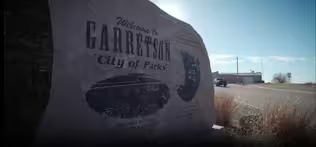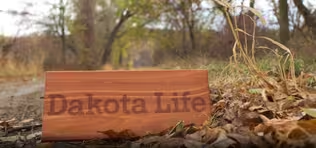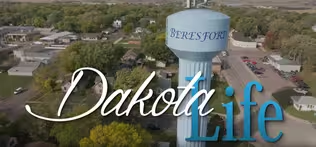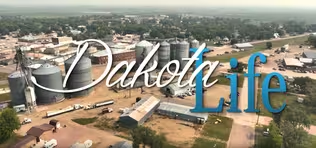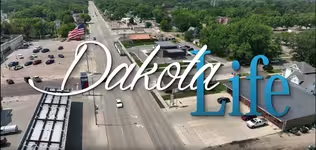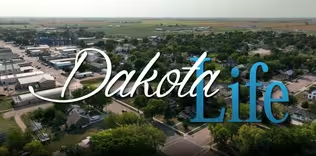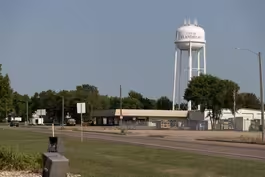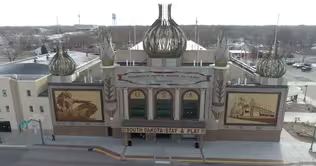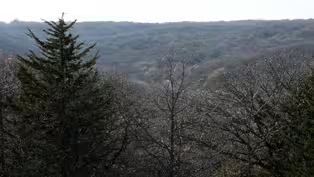Dakota Life
Greetings from Howard
Season 25 Episode 4 | 29m 34sVideo has Closed Captions
Greetings from Howard
On this episode of Dakota Life, we learn about Howard's Friday night football tradition. Visit a collector keeping history alive with postcards. And stop by an iconic family-owned grocery store, plus we check in with the local meat locker down the street.
Problems playing video? | Closed Captioning Feedback
Problems playing video? | Closed Captioning Feedback
Dakota Life is a local public television program presented by SDPB
Support Dakota Life with a gift to the Friends of Public Broadcasting
Dakota Life
Greetings from Howard
Season 25 Episode 4 | 29m 34sVideo has Closed Captions
On this episode of Dakota Life, we learn about Howard's Friday night football tradition. Visit a collector keeping history alive with postcards. And stop by an iconic family-owned grocery store, plus we check in with the local meat locker down the street.
Problems playing video? | Closed Captioning Feedback
How to Watch Dakota Life
Dakota Life is available to stream on pbs.org and the free PBS App, available on iPhone, Apple TV, Android TV, Android smartphones, Amazon Fire TV, Amazon Fire Tablet, Roku, Samsung Smart TV, and Vizio.
Providing Support for PBS.org
Learn Moreabout PBS online sponsorshipMore from This Collection
Greetings from Wessington Springs
Video has Closed Captions
Most cities shape the landscape they’re on, but in Wessington Springs it’s the other way around. (29m 45s)
Video has Closed Captions
Discover the beauty and history of Palisades State Park, goat yoga, and a very special love story. (29m 46s)
Video has Closed Captions
Beresford hosts the Frostbite 4, a regional favorite winter road race. (26m 26s)
Video has Closed Captions
From a window to the past to raising the next generation, Dakota Life explores Wagner. (28m 53s)
Video has Closed Captions
Greetings from Madison, the center of Lake County. (28m 55s)
Greetings from the Corn Palace
Video has Closed Captions
Greetings from the Corn Palace plus stories from southeast South Dakota and Aberdeen. (26m 16s)
Video has Closed Captions
Dakota Life showcases Newton Hills and the SD State Park system. (28m 5s)
Providing Support for PBS.org
Learn Moreabout PBS online sponsorship- [Narrator] This is a production of South Dakota Public Broadcasting.
(gentle music) - The village of Howard was founded in 1881.
It's a few miles west of the Vermilion Hills and near the almost-imperceptible West Fork of the Vermilion River.
James D. Farmer was Townside proprietor.
The Chicago, Milwaukee, and St. Paul Railroad built a depot that year and the first trains arrived in early December.
Howard "Advance" editor S. H. Bronson recorded the first Christmas dinner in Howard at the home of the Lincoln family.
After dinner, the parties skated until dark on nature's rink, a frozen pond.
Well, by the following year, Howard had four mercantile, three law offices, two churches, two hotels, a restaurant, saloon, hat shop, harness shop, and the Miner County bank.
A flour mill was established in 1884.
Just four miles west the town of Vilas sprang to life with a crossroads for both the Milwaukee Road and the Chicago and Northwestern railways.
Some Howard residents feared that with the rail connections Vilas would eclipse Howard as a commercial center.
But by the Depression years Vilas was in decline.
Many Norwegians migrated to Miner County and to Howard.
Some came via other Midwestern states while others arrived from the Nordfjord region of Norway on the Norwegian Sea, so much so that there's a hard surface road going north nicknamed the Norwegian Oil.
The Miner County population peaked at about 8,500 in the 1920 census but right after The Depression hit hard.
Margaret Spader Neises was a farmsteader whose diaries were compiled in "The Dust Bowl Book of Days" in 1932.
Her last recollections of the Howard area frequently concerned rabbits.
The Neises family trapped them for pelts and food.
"All these rabbits must be hell spawn," she wrote.
"I can not eat another on a bet."
Today there are just over 2300 residents in Miner County.
Howard is the county seat, but commerce has certainly changed.
The hat shops and the harness shops are gone.
The locally founded Horizon Healthcare has grown its downtown footprint.
Agriculture is still the mainstay in the Howard economy and it's way of life, just as it was in the time of that first Christmas dinner.
Welcome to Dakota Life and greetings from Howard.
(lively country music) - [Narrator] Support for this program comes from Horizon Healthcare, keeping communities well throughout South Dakota with primary medical care, dental, and behavioral health services, and by Howard Farmers Co-op, working together to support local agriculture and a proud part of this vibrant rural community.
- In 1883, a Catholic priest and medical doctor named Father William Kroeger moved from Elkhart, Indiana to the tiny town of Epiphany.
That's just southwest of Howard.
There were no other doctors in Epiphany.
So Bishop Martin Marty encouraged Kroeger to put his medical training to use.
He built a laboratory where he developed medicines.
Many believed he created a cure for skin cancer.
He also claimed treatments for epilepsy, nervous disorders, and consumption.
News spread of a priest healer with miracle cures.
People traveled from around the country and even around the world.
The clinic was soon treating hundreds of patients every week.
Literally an empire grew in Epiphany.
Kroeger built a hospital, two hotels, a bank, two general stores, a lumberyard, and a drug store.
He provided Epiphany with an electric light plant, ice plant, waterworks, and a paper box manufacturing plant.
Well, Kroeger passed away in 1904 and his town within a town soon disappeared.
After his death questions were raised about the authenticity of his medical license.
A more conventional and longstanding business is Dold Implement in Howard.
Frank Dold founded the company in Canova in 1936.
Then it moved to Howard a year later.
Horizon Healthcare grew out of Miner Hamlin Healthcare.
The South Dakota based organization runs 32 medical and dental clinics that see patients on a sliding fee scale.
Horizon operates a clinic and an office building in downtown Howard.
Then there's the nine hole Howard Golf Course.
It's a local point of pride and home to Howard's only full-service restaurant.
The Miner County Historical Society Rural Life Museum preserves artifacts and documents from the Howard area's history.
The museum is currently in the process of renovating and moving into the Old Rivers Edge Bank building on Main Street.
Coming up, we're going to explore the sights and the sounds of Friday Night Football with the Howard Tigers.
We're gonna look over a collection of postcards from a connoisseur, literally see how the sausage is made at Howard Cold Storage.
But first, let's check out the weekly specials at Rusty's, the locally owned hometown grocery store.
- We run a real nice store, I think real clean.
We keep everything they need, I think, here.
And you know, we keep the prices as low as we could.
It's way different than when I started.
- [Larry] For more than six decades the Hiltunen family has owned the grocery store in Howard.
Rusty came to the area through his love with America's pastime.
He was one of the top baseball players of his era in South Dakota.
Today he's in the state's amateur baseball hall fame.
- Yeah, I signed a Giant in 1950 and I signed when Willie Mays signed and went to spring training and he was out there too, and whatever, but then I pitched for Canova, started a program there and pitched for them and Canova's done well ever since.
- [Larry] Today the store in Howard is still family-owned.
Rusty's son Rick runs it.
- Done everything here.
You know, you start at the bottom and there's, you know, I don't ask anybody to do anything I haven't already done.
And there's no job that is too small for anyone or too big for anyone, you know.
You're only as strong as your weakest link.
Fresh meat, fresh produce, we take a lot of pride in that.
We work very hard at it.
We have deliveries twice a week of those fresh items.
We can get them more if we need, or I'll call it stickers on that stuff.
The produce, you know, from the time they pick that apple in Washington State, it's our responsibility to try and get it out the front door before something goes wrong with it.
- [Larry] It's the small town feel that keeps people shopping at Rusty's after all these years.
- Yeah, I come and go as I want.
Whenever they get mad at me, I leave.
I'm just kidding.
(chuckles) But, anyway, it's been, we get along real good.
- [Larry] Rick's daughter Katie is next in line to take over the day to day operations of Rusty's grocery store.
- I grew up here, grew up in this store essentially.
I kind of grew up working here, doing, it was home.
That was what it really means to me, I guess, and what it used to mean.
So yeah, I wanted to move back home.
I felt the need to help out my family and this was the way that I could do it.
I could help my dad out, help my mom, and to continue it to be in our family.
I was the option.
So just to keep it in the family.
- You know, I'll probably be a thorn in her side for a while yet hopefully, but I always tell her it's payback from her younger days.
(chuckles) What goes around comes around, so, but, yeah, I'm excited about that.
- We mean everything to this community and the community means everything to us.
We wouldn't be here if they didn't shop here, if they didn't support us.
And that's how we give back, by supporting the community.
- [Larry] This soon-to-be three-generation business hopes to continue to stand for plenty more years to come.
- Just keep smiling and it really, feels really good to have it, have it still going along.
It's going good.
- In August of 1884, a series of tornadoes rocked this part of the state.
Wind speeds of over 200 miles per hour were recorded.
During the storms Howard photographer F.N.
Robinson captured what is one of the most well-known photographs ever taken of a tornado.
In the picture the storm dominates the horizon, rising from three vortices.
Robinson's photo is rumored to have inspired the editor of the Aberdeen newspaper, L Frank Baum, to write "The Wonderful Wizard of Oz."
Howard has faced its share of storms and catastrophes.
In 1881, as the town was founded, winter storms brought snow drifts as high as 20 feet, blocking railroads and killing cattle.
The hailstorm of 1884 destroyed crops, livestock, and property throughout Miner County.
In 1888 there was the schoolhouse blizzard which struck as children were leaving school.
It hit a wide swath of the great plains but fortunately there were no casualties here in Howard.
In 1892, it was fire that destroyed most of the business district.
Three years later, the flour mill was destroyed by a boiler explosion.
As the Dust Bowl years hit Miner County, the ag economy was hit hard too.
Through the setbacks, Howard has learned to harness potentially destructive powers like the wind to build a stronger community.
In the 1990s, Howard High School students launched a buy local campaign to keep tax revenues here in town.
The effort was a success and students, along with local leaders, began researching potential opportunities for development.
In 2001, Howard partnered with a regional charity, the Northwest Area Foundation, to create a community plan.
That year Howard became the first municipality to own and operate its own wind turbines, two 80-foot-tall towers capable of producing 1.2 million kilowatts of power per year.
Since then, that use-what-you-have mentality has spread like a prairie fire across the state.
Wind energy now accounts for over 30% of South Dakota's electric power.
Coming up next, a postcard from Howard.
- Here's one of the farmer's elevator that burned in 1912 and all these pictures, I think, are Lubeck's He was a famous photographer in Howard.
- [Larry] Gene Feldhaus has collected a lot of things during his lifetime, including a lot of old photos of his hometown of Howard.
- Well, I like all the old architectural buildings, the buildings that were on the Main Streets and whatever.
- [Larry] He also has pictures of other Miner County buildings.
Some of the old buildings are still standing.
Some of his pictures are very rare.
Feldhaus says he's never seen another copy of this one taken in Yankton in the 1880s.
- It is the land rush and there's hundreds of people way back to here.
And if you look at it with a magnifying glass, you can see some of them even are sitting on chairs.
- [Larry] Like many collectors.
Feldhaus is interested in all kinds of things.
- I think that's the guy that wrote us, Billy the Kid, I'm quite sure it is.
- [Larry] You're one of those guys who doesn't limit yourself to just one thing.
Like you're not the guy who collects old metal toys, for example.
- Correct.
Yeah, I was into that though in the early 70s and I finally sold the whole collection in the 70s.
- [Larry] But he is not that interested in buying and selling stuff.
The feeling he gets when he finds something old and rare is what keeps him going.
- It's an adrenaline rush.
I'm addicted to an adrenaline rush.
- [Larry] And he has been since he was a kid.
- Since I was like five years old, found my first flintlock pistol, arrowhead, and a Indian Head penny and that's pretty much what did it.
- [Larry] He's especially interested in really old stuff.
- I mainly like Dakota territory stuff because it's so rare.
You just don't find it, you know, and I have some, but I don't know, maybe 25 pieces, but most of it's paper.
- [Larry] But there's a lot to be learned from old papers.
- What they put in the newspaper.
I mean, there was a school teacher, I don't know if we can record this, but, school teacher's having an affair with a married man.
They ran her out of town for that, yeah, and-- - [Larry] He got to stay though.
- Yep, yep.
- [Larry] They just didn't talk to him in church.
And then there are the store tokens.
You don't see these anymore, but - About any business, most of the businesses, you went into their store and bought something and they might give you a token back with a certain amount of money, cash value, for you to come back to the store.
- [Larry] It might be hard to find anyone who remembers Howard's old businesses and harder still to find somebody still holding onto one of these tokens.
And that's why Gene Feldhaus's hobby matters, at least to the people in and around Howard.
- Well, I don't really want them to forget about the history, the people that came here.
You know, I can drive around in the country, same as you, and look at all these homesteads that are gone.
That was somebody's dream in the 1800s.
Most of them in the 1800s, they're are gonna come and settle here and farm, live out their life.
And it didn't work out.
- [Larry] Feldhaus plans to leave the stuff he's collected to his kids, but he knows they won't get rich off it.
- There's probably no monetary value to it very much.
But the people, the history, just the history, what went on here.
- The old Nansen store site in a rural area, northeast of town, is an historic monument to the local Norwegian community.
The store was established by Knut Skaar in 1903 and named for Fridtjof Nansen, a famous Norwegian Arctic explorer and Nobel Peace Prize winner.
Nansen first made his name as a champion skier and ice skater.
He used the expertise for a North Pole expedition in 1886 that reached the northernmost latitude achieved at that time.
Two years later, he led the first expedition to cross the icy Greenland interior.
Nansen leveraged his name recognition as a diplomat, helping Norway achieve independence from Sweden in 1905.
Later he served as the League of Nation's high commissioner for refugees.
In 1922, he won the Nobel Peace Prize for his work directing aid to victims of famine in Russia.
So the Nansen name was well-known among Norwegian immigrants who founded the Nansen Country Store and the small community that anchored it.
Like many Norwegian American settlements, the Nansen community never formally became a town, but it had a post office, church, telephone company, creamery, blacksmith, and of course, a general store.
Nansen even fielded a baseball team that played on a diamond just south of the store.
For many years the Nansen store was the center of community life.
Neighbors gathered there to visit, play cards, or watch sports in the television era.
In 2013, an extensive renovation was completed and the Nansen store site was listed on the National Register of Historic Places a year later.
Many South Dakotans remember towns that once were.
Here in the Howard area some remember towns that never were.
One kind of store often seen in rural communities is the local meat locker, a service to local farmers and where customers go to stock up.
- I actually bought in, in 2004.
In 2014 I solely owned it, but in 2013 we burned down.
- [Larry] Tim Glanzer and his wife Brenda had just committed to take over full ownership of the cold storage and locker and it was gone.
But there was another meat processing facility in Howard and it was between owners.
- And right away the banker was outside on Main Street.
And I said something to him and he said, "Well, I don't think there's nothing going down at the plant down there."
So I guess we all got together and went down there and we got hacksaws and grinders and stuff from Hobart's out of Sioux Falls and they had the kill facility there, so there wasn't whole lot we needed for that.
This happened Thursday and we were going by Saturday.
- [Larry] So within 48 hours they were back up and running and the temporary facility was a game changer.
- Yeah, if that place wouldn't have been there, then I don't know if I would've rebuilt, you know, 'cause it had been six, eight months and, you know, I don't know, it would've been a tough choice.
- [Larry] It wasn't an easy decision to rebuild.
The temporary facility was just too big.
And it's now owned by Quality Meats and specializes in bacon.
Tim and Brenda have gone on to develop a popular line of meat sticks and jerky.
- We started with just regular sticks and then we did cheese, then we did jalapeno cheese, then we did honey barbecue probably what, three years ago?
- Yeah, longer, more than that, maybe five.
- Five.
And that's kind of a sweeter one.
That's been a big, big seller.
And the jerky, we started with just regular and we just went with a hot, then we added the black pepper, and then we also do a teriyaki.
But the black pepper's getting to be more and more popular.
You would think it would be hot, but it's not.
It just does a nice bite.
- [Larry] And they've added some ready made local foods like kuchen and cheese.
- Well, yeah, they come in and ask if we wanted to sell it for them.
We're like, "Well, okay."
We're not sure they'll go, because I don't know if these people know, well, their truck was sitting outside and there was people before we got them in the freezer were buying them, because we didn't even know we were gonna sell them for, it's like.
But yeah, we get, I mean, Dimock cheese.
We do their cheeses and we just do a few other things for people that ask, "Hey, would you guys consider selling this?"
"Okay, we'll try it."
- [Larry] While they've won many awards for their sticks and jerky at the annual meeting with other locker owners in the state, processing livestock from local farmers is the core of their business.
But it does make for some long days.
- We're kind of short of help, so right now we're coming in at 4:00, 4:30 in the morning and then we start cutting beef and right now we're working until 4:30 at night.
And on Tuesdays and Thursdays I have to go butcher.
My dad, he's what?
He's 76 years old, he comes in and helps me.
- [Larry] But that work means a good price for local farmers, business for the locker, and a great deal for customers who buy in bulk.
- Well, when they get a quarter of beef, you know, it's that in initial hit, you know, I gotta pay the farmer this much for this quarter and then now you're set for, you know, six, eight months and it's a whole lot cheaper.
I've done a lot of pencil work and what you take out of here after you pay your processing and your farmer, it's only probably between 6 and 7 and a quarter a pound, what you take home, compared to if you'd go buy some ribeyes for 14.99.
- Ten miles south of Howard is Canova.
With a population of a hundred or so, Canova is a legendary small town in South Dakota sports.
The Canova Gang, the local Corn Belt League amateur baseball team, has been hitting above its weight since the 1930s.
South Dakota Sports Hall of Famer Dave Gassman played and coached for the Gang for nearly 50 years.
Gassman pitched in nine state finals, winning three, and he holds a state record for career strikeouts and wins.
Gassman started his last championship in 1999 at the age of 50.
Since retiring from the diamond, he still plays a starring role in raising funds to keep the small town's ballpark in big league condition.
Members of the Gassman extended family feature heavily in the Canova Gang's current lineup.
Howard's own Wayne Rasmussen is another local sports legend.
In high school Rasmussen led the Tigers to the 1960 Class B State Championship.
At South Dakota State University, he won the North Central Conference MVP Award for football in 1962 and a year later he led to Jackrabbit's men's basketball team to the NCAA championship, winning Most Outstanding Player.
Rasmussen went on to play for the Detroit Lions and the NFL from 1964 to 1972.
Over the years the Howard Tigers have fielded more than a few great sports teams and people around here rally around their young athletes every game night.
Friday nights in the fall, it's when hits become highlights.
- [Student] Friday nights are special.
I mean, I'm a senior and I know it's gonna be something I miss a lot, but I mean they're crazy.
There's just nothing like them.
- [Larry] Where cheers echo into the night sky.
- [Cheerleaders] Let's go, Tigers.
- [Larry] When the lights shine the brightest.
- [Student] Friday nights are just, I think, the highlight of my week.
It's just everything I look forward to that whole week until it's that day.
And you know, right before that game nerves are rattling.
It's just an awesome feeling.
- [Larry] Moments become mortal.
- [Sports Announcer] That's your 9A champions.
55-18 is your final score, Howard claims the championship.
- [Larry] But before kickoff, a lot of work needs to happen.
Game day for head coach Pat Ruml starts in a way you may not expect: (lawn mower revving) Giving the field a fresh cut.
- When I first got here, we had some of our janitors did the work on it and they were really good 'cause they'd been here for a while, so I didn't have to do any of that stuff.
Then they retired and then nobody else kind of took it over.
So I think one or two of them might have tried and they, it wasn't a very, it wasn't a job that I liked how, you know, how it was done.
So I just figured from then on, you know, if I wanted it done how I wanted it done, I had to do it myself.
- [Student] Pat Ruml, his field is his baby.
He takes care of that night and day, make sure it's ready to go.
- Your football field is sort of an imprint of what your community's like.
And I think if you have a sloppy field and one that's not taken care of, it kind of symbolizes maybe a little bit about your community.
So that's just always been my theory.
And so obviously we try to keep topnotch things out here and I like to make it so when people see our field, it kind of symbolizes Howard as the the school we are and the community we have here.
- [Larry] With the grass looking good, the stands are ready for fans who have been filling them for years.
- Oh, probably between the people in Canova, 50 years.
You know, I've gone to football games when we were still in Canova and then when they moved up here, I started coming to these games, sporting again.
(fans cheer) (whistle blows) - Good blocking, guys.
- Born and raised in Howard.
Been going to football as long as I can remember.
I never missed game, any sporting events, and we just love the community, love the pride for the Tigers and it's just wonderful to be a part of it.
(fans chanting) - The time I told them I had to get out to the football, that's when I broke my hip and I had surgery on a Thursday and I said I was gonna be out the next day to watch the playoff game here.
"Oh, no, no."
Well, I told them I was just gonna leave, (laughs) but they let me out and I just watched it at home that night and we got beat.
- It really just shows like how much the football team means to our community and it's just really fun to get everyone together and show how much it means to us.
- [Larry] The Tiger fans now fill the stands, continuing the rich tradition that is Howard Tiger football.
- At the beginning of the year, every year, it's right on our offensive playbook that we get handed out and it says, "Tradition doesn't graduate."
That's a big thing for us.
We know we always have big shoes to fill coming up, but we're, it's our, it's a new year.
It's not last year, it's not next year.
We're just looking to be successful.
- Just Howard Tiger football, we're gonna see a lot of alumni back on the field and they want to come back and they want to cheer on these kids that they've either played with or that they've known since they were little.
Me working at the elementary, obviously, I see the kids that play football at recess, the kindergartners trying to play with the fifth graders, trying to be that Howard football that they know.
- [Local] Yep, I was glass of '96.
We played on the football team and we went from 9 man to 11 man for quite a long run there.
And it was quite a learning experience, but we had a lot of fun with it and it just a thrill to be out on the field and a thrill to be in a stand watching my son now.
(Cheerleaders chanting) - My brothers played two years ago and four years ago or whatever.
And now I'm a cheerleader and kind of following the whole Howard tradition and here we are today.
- It's meant a lot.
Just, I grew up around football.
It's always just been part of me, runs deep in my family.
It's really a fun sport for me to play and it's exciting.
- [Sports Announcer] Number 30 Griffin Clubb.
- [Coach] The easiest part of my week is Friday night when the game starts.
When the kickoff happens, that's obviously the most fun for me.
- The Howard boom happened almost overnight.
The Miner County seat sprang to life almost as soon as those late winter snows melted in 1882.
The young town weathered blizzards, a major fire, and other catastrophes and then along came The Depression and rabbit stew years.
Howard is along the highway 34 corridor and while it's not a long drive going east to Madison or west and south to Mitchell, Howard is still a service center to farmers all throughout the area.
Like many small towns, Howard has downsized while even smaller towns in the area like Vilas and Argon and Nansen have simply vanished.
Howard's potential is underwritten by the soil as well as by the ideas and the work ethic of its people.
What propels Howard forward is a combination of trying out new ideas and sticking with the tried and true, cheering on young people, and sometimes passing it along for the next generation.
It's symbolized by the Dold Implement sign over Main Street downtown and on the west side of town where the wind turbines spin tales of what the future could bring.
You can revisit stories about Howard and other communities at sdpb.org/DakotaLife.
Thanks for coming along.
I'm Larry Rohr and for all of us at SDPB, thanks for watching.
(lively country music)
Support for PBS provided by:
Dakota Life is a local public television program presented by SDPB
Support Dakota Life with a gift to the Friends of Public Broadcasting

